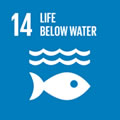Por favor, use este identificador para citar o enlazar a este item:
http://hdl.handle.net/10261/341167COMPARTIR / EXPORTAR:
 SHARE SHARE
 CORE
BASE CORE
BASE
|
|
| Visualizar otros formatos: MARC | Dublin Core | RDF | ORE | MODS | METS | DIDL | DATACITE | |

| Título: | Marine heatwaves on the rise: One of the strongest ever observed mass mortality event in temperate gorgonians |
Autor: | Estaque, Tristan; Richaume, Justine; Bianchimani, Olivier; Schull, Quentin; Mérigot, Bastien; Bensoussan, Nathaniel CSIC ORCID; Bonhomme, Patrick; Vouriot, Pauline; Sartoretto, Stéphane; Monfort, Tiffany; Basthard-Bogain, Sòlene; Fargetton, Margaux; Gatti, Giulia; Barth, Laura; Cheminée, Adrien; Garrabou, Joaquim CSIC ORCID | Fecha de publicación: | nov-2023 | Editor: | John Wiley & Sons | Citación: | Global Change Biology 29(22): 6159-6162 (2023) | Resumen: | Climate change is currently impacting and threatening the entire biosphere, especially coastal marine ecosystems (Harley et al., 2006). In particular, climate change has been identified as a major driver of loss in coastal marine biodiversity and ecosystem functioning linked to the increase in the frequency and the intensity of marine heatwaves (MHWs)—anomalously prolonged periods of warm ocean temperatures or extremely warm temperature during short periods (Smith et al., 2023). The Mediterranean Sea has particularly experienced widespread mass mortality events (MMEs) driven by MHWs across the basin over the last two decades (Garrabou et al., 2022). During summer 2022, the NW Mediterranean was affected by one of the strongest MME ever recorded in the region affecting several species including gorgonians, sponges, bryozoans, bivalve molluscs, and calcareous algae. As in previous MMEs, mortality in these species resulted in the development of tissue necrosis affecting part of or the entirety of colonies (Figure 1a). In the Calanques National Park, France, two of its most emblematic species, the red gorgonian (Paramuricea clavata) and the red coral (Corallium rubrum), were dramatically affected. [...] | Descripción: | 4 pages, 1 figure, supporting information https://doi.org/10.1111/gcb.16931.-- Data Availability Statement: The data that support the findings of this study are openly available in Zenodo at https://urldefense.com/v3/__http://doi.org/10.5281/zenodo.8279819__;!!N11eV2iwtfs!oJ0au6jZIkmEkpeqJuRSFRJPgLXP0w9KwTA7kUivI2mOPyRhgVhXVWdBzeLbhI9X1e0-VVS_kZbgfWWD_ebA7eA$ | Versión del editor: | https://doi.org/10.1111/gcb.16931 | URI: | http://hdl.handle.net/10261/341167 | DOI: | 10.1111/gcb.16931 | ISSN: | 1354-1013 | E-ISSN: | 365-2486 |
| Aparece en las colecciones: | (ICM) Artículos |
Mostrar el registro completo
CORE Recommender
SCOPUSTM
Citations
7
checked on 24-abr-2024
WEB OF SCIENCETM
Citations
3
checked on 29-feb-2024
Page view(s)
13
checked on 30-abr-2024
Google ScholarTM
Check
Altmetric
Altmetric
NOTA: Los ítems de Digital.CSIC están protegidos por copyright, con todos los derechos reservados, a menos que se indique lo contrario.


